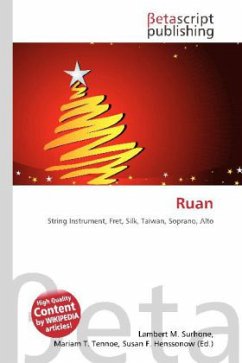
Ruan
Versandkostenfrei!
Versandfertig in 6-10 Tagen
32,99 €
inkl. MwSt.

PAYBACK Punkte
16 °P sammeln!
Please note that the content of this book primarily consists of articles available from Wikipedia or other free sources online. The ruan is a Chinese plucked string instrument. It is a lute with a fretted neck, a circular body, and four strings. Its strings were formerly made of silk but since the 20th century they have been made of steel (flatwound for the lower strings). The modern ruan has 24 frets with 12 semitones on each string, which has greatly expanded its range from a previous 13 frets. The frets are commonly made of ivory. Or in recent times, metal mounted on wood. The metal frets p...
Please note that the content of this book primarily consists of articles available from Wikipedia or other free sources online. The ruan is a Chinese plucked string instrument. It is a lute with a fretted neck, a circular body, and four strings. Its strings were formerly made of silk but since the 20th century they have been made of steel (flatwound for the lower strings). The modern ruan has 24 frets with 12 semitones on each string, which has greatly expanded its range from a previous 13 frets. The frets are commonly made of ivory. Or in recent times, metal mounted on wood. The metal frets produce a brighter tone as compared to the ivory frets. It is sometimes called ruanqin, particularly in Taiwan. The ruan is now most commonly used in Chinese opera and the Chinese orchestra, where it belongs to the plucked string section. The instrument can be played using a plectrum similar to a guitar pick (formerly made of animal horn, but today often plastic), or using a set of two or five acrylic nails that are affixed to the fingers with adhesive tape. Mainstream ruan players use plectrums, though there are some schools which teach the fingernail technique, similar to that of the pipa.












